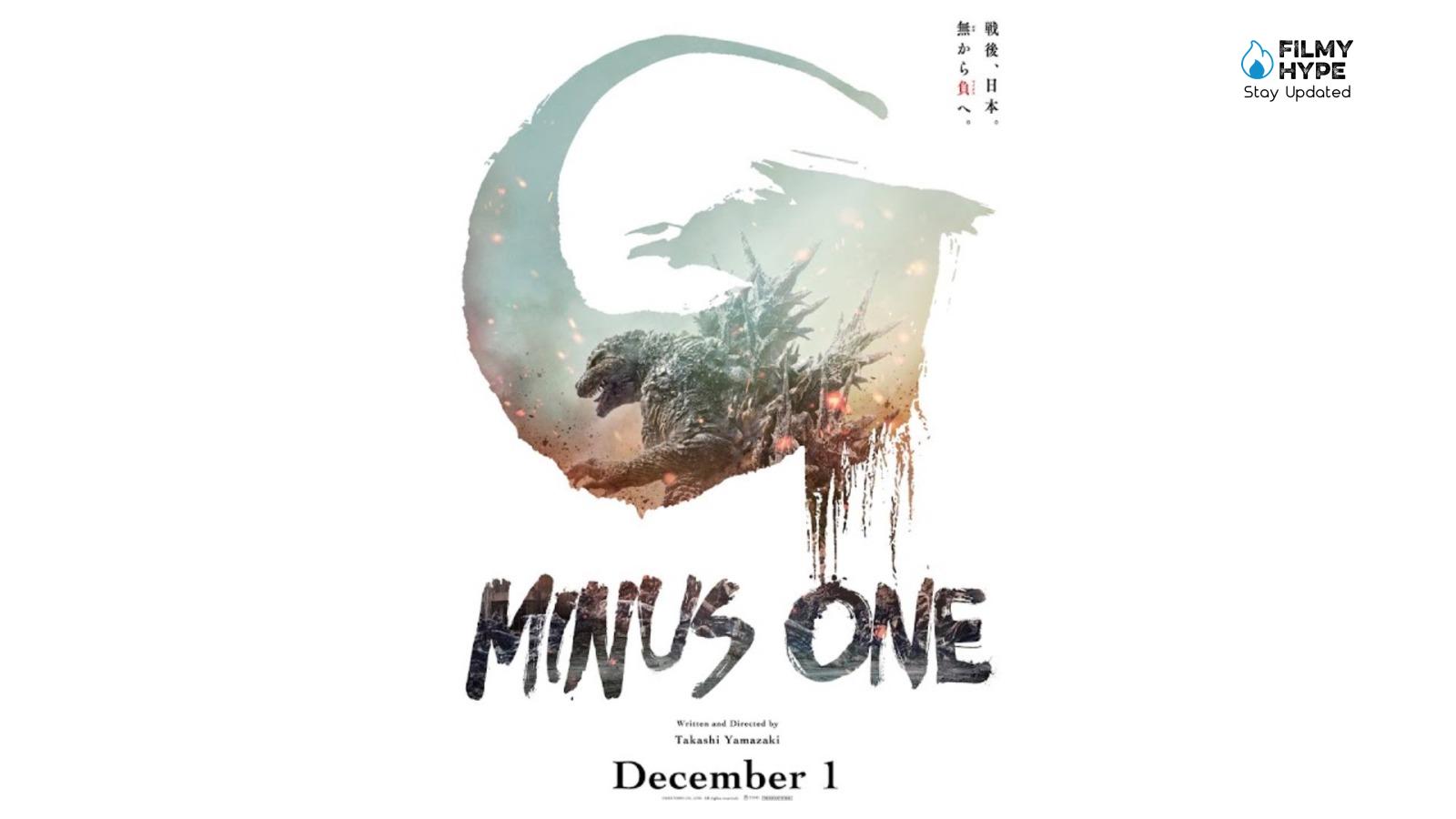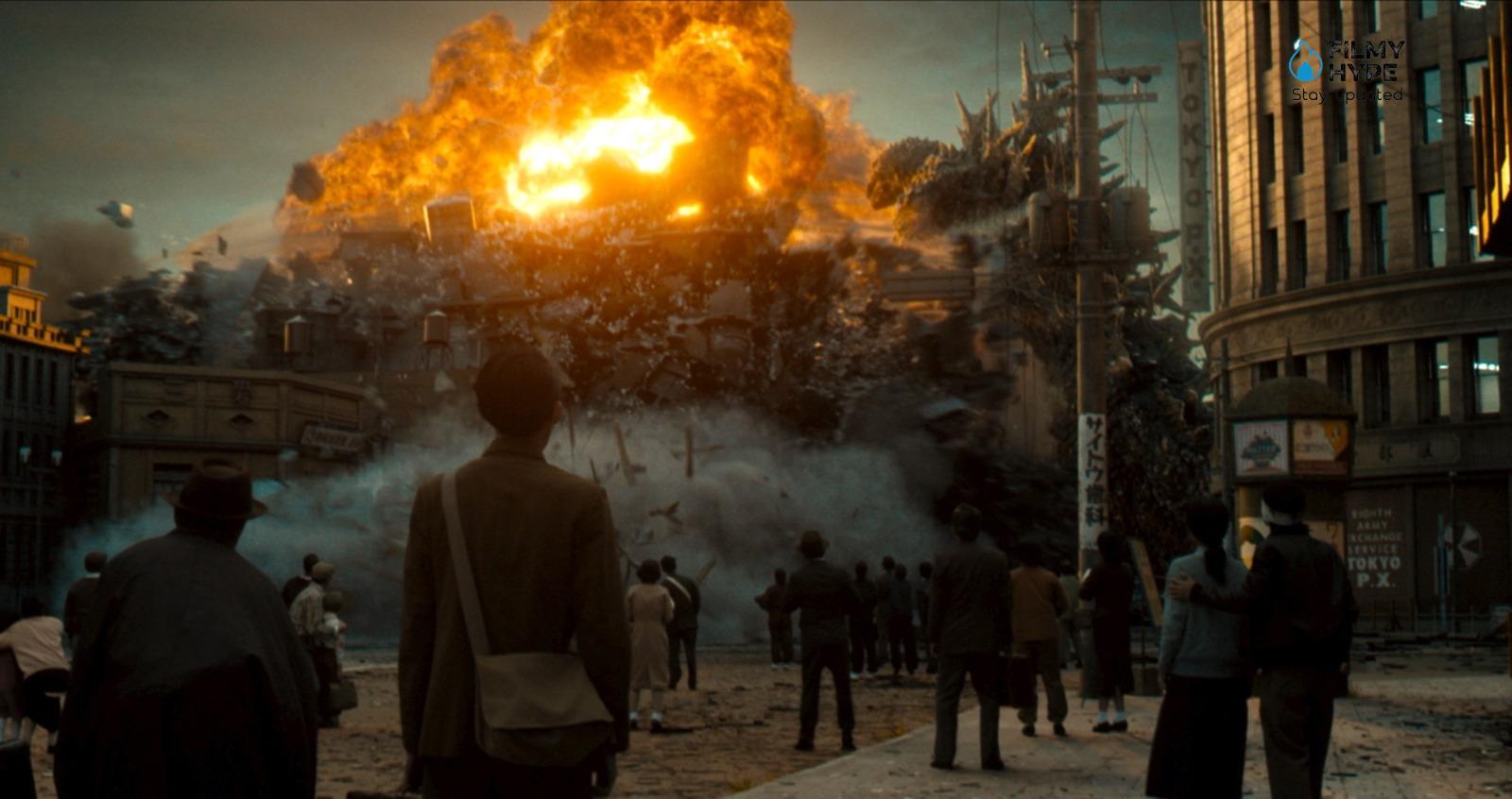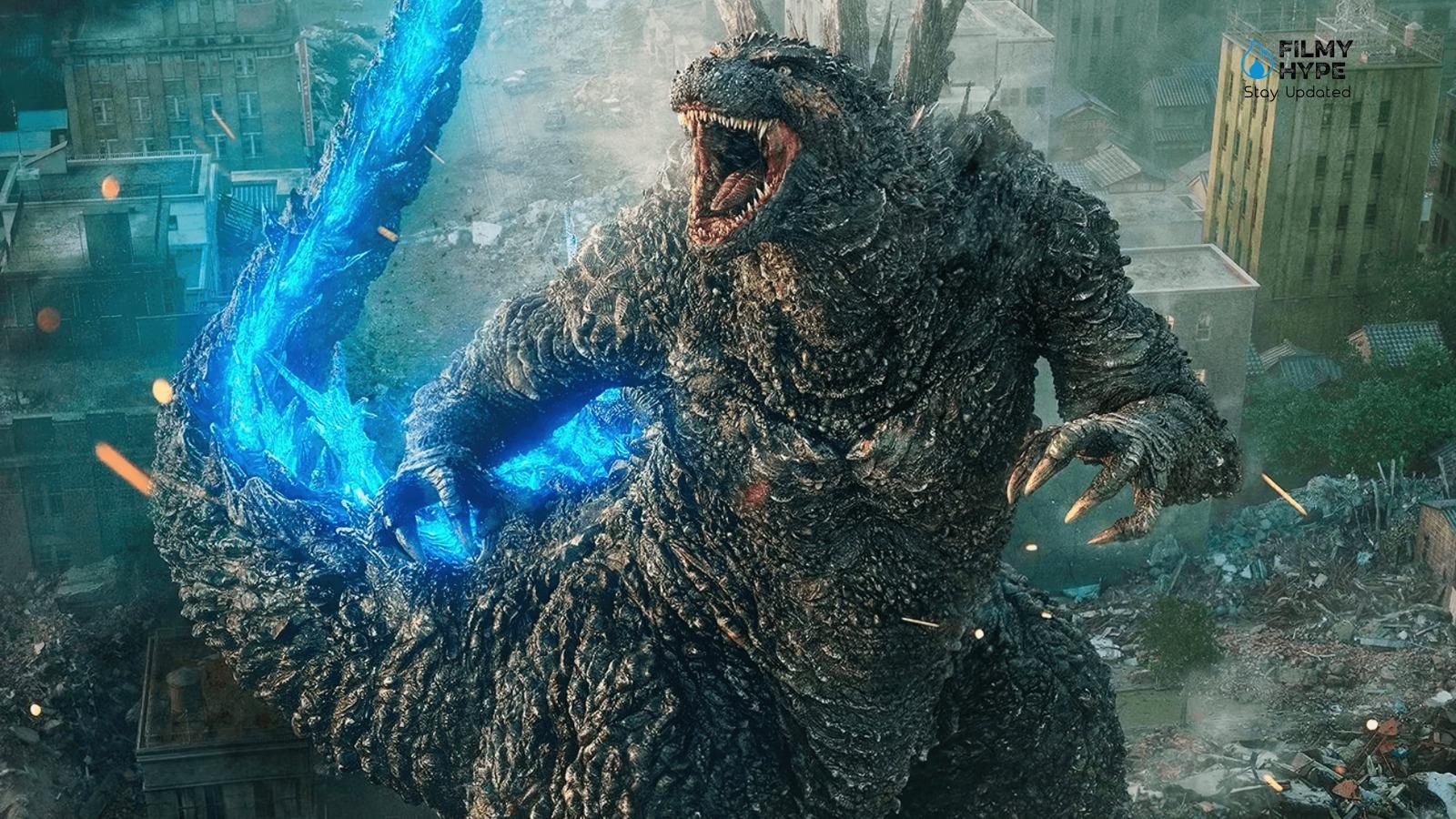Godzilla Minus One Review: It Is An Epic Film With Breathtaking Scenes And A Beautiful Soundtrack
Cast: Ryunosuke Kamiki, Minami Hanabe, Yuki Yamada, Munetaka Aodi, Hidetaka Yoshioka
Director: Takashi Yamazaki
Where We Watched: In Theaters
Filmyhype.com Ratings: 4/5 (four stars)
Godzilla Minus One comes out just before the 70th anniversary of the original 1954 “Godzilla” by Ishirô Honda, director of eight titles in the Godzilla saga and pioneer of kaiju-Eiga, the genre of gigantic monster films to which he dedicated his career. The film is unrelated to the current American Godzilla franchise, whose next sequel, Godzilla x Kong: The New Empire, is announced for 2024. Godzilla is enjoying new popularity in the West thanks to several projects aimed at it. Legendary continues to expand its MonsterVerse and a series dedicated to it, Monarch: Legacy of Monsters, has recently been released on Apple+. Nearly 70 years old and more than 35 films into the series, it’s a testament to the enduring appeal of a giant reptile-like Godzilla that films about him can still surprise. In this century alone, we’ve seen him clash with an alien race of Xilians in “Godzilla: Final Wars” and inspire the Kafkaesque satire of “Shin Godzilla.” Whichever genre lands on Godzilla’s thorny back will be well taken care of, which helps explain the true rebirth of this new chapter.

Godzilla has been an icon of world popular culture for almost seven decades, with various versions created by the Japanese Toho and American production companies. And it is precisely to celebrate the seventieth anniversary, albeit a year early (because by contract a film from Toho and one from Legendary, which produces American feature films about the famous lizard, cannot be released in the same year), that a new film, a return to its origins which has already conquered the Japanese public and is now preparing to do the same on an international level, as a release-event lasting a few days (and only in the original language with subtitles). It’s that event that we talked about in our review of Godzilla Minus One.
Godzilla Minus One Review: The Story Plot
1945 The Second World War is ending, and Koichi Shikishima, a kamikaze pilot, lands on Odo Island due to an alleged failure of his plane. That night almost all the soldiers present are killed by a giant reptile that the region’s inhabitants had talked about: Godzilla. Two years later, Koichi, one of the few survivors, has moved to Tokyo and made a life for himself, but nothing will be able to eradicate the memory and trauma of that night on the island. Especially when Godzilla re-emerges from the waters, further magnified by American nuclear tests, and destroys several warships before swimming toward the Japanese capital. With the help of old and new friends, Koichi can overcome the mental obstacle and do what is necessary to take down that monstrous creature. Koichi Shikishima (Ryunosuke Kamiki) is a kamikaze pilot who survived the war, returning to his neighborhood he discovers that his family has died in the bombings and that all that remains is the rubble of what was once his home.

Koichi carries a big burden on himself, he survives at the expense of others. Godzilla’s narrative starts from the bottom: we see events through the eyes of Koichi, his neighbors, and his colleagues, rather than through great government leaders, expert scientists, or superhuman soldiers. As with any great kaiju film, we spend much of the first half of the film getting to know the protagonists and becoming attached to their stories just before their world is devastated. Koichi is an unusually dark protagonist, even by the standards of the early Godzilla films. He despises himself for his decision to abandon his kamikaze mission, and his neighbors, who have lost their homes and families, aren’t particularly thrilled to see him either. Nonetheless, together they rebuild the country and help each other. In contrast to American productions, Godzilla Minus One is a dark and sad film about how Japan – or humanity in general – is unable to break a cycle of wartime annihilation. The themes touched upon are complex and profound and make it a monster film with a solid plot.
Godzilla Minus One Review and Analysis
Written and directed by Takashi Yamazaki (Lupine III – The First, Space Battleship Yamato), who also handled the visual effects, Godzilla Minus One is a Japanese film belonging to the kaiju genre and set in Japan starting from 1945 at the end of the second World War. The plot focuses on the appearance of Godzilla and Japanese society’s response to this impressive threat. According to Honda film lore, Godzilla was a huge marine animal mutated due to radiation from the nuclear bomb. It was more than a dinosaur that could be defeated with weapons. It was a physical manifestation of post-war nuclear devastation, a monstrous legacy of what weapons of mass destruction had wrought. Becoming a Japanese icon almost immediately after his cinematic debut, the public’s love for the character led Toho to put a twist on him and turn him into the country’s gentle defender for several films, its protector against other monstrous adversaries such as the dragon three-headed Ghidorah or the robot Mechagodzilla.
In this film, however, Godzilla is not a metaphor for nuclear devastation nor even a defender but appears as the embodiment of the trauma of war. Godzilla Minus One sticks to the original recipe, the film that started it all, mixing horror, classic melodrama, and a feverish anti-war message. The feature film starts from 1945 until reaching the 1950s, a complex historical period for Japan. After the Second World War and the bombings of Hiroshima and Nagasaki, the country is marked by these tragic events. Mourning and trauma affect the Japanese who hope as best they can to return to normal life. It is amid reconstruction that their hopes are destroyed by a new supernatural catastrophe. The atomic damage caused by the American army has awakened a monster that is preparing to destroy the entire country: Godzilla. Far from the excesses of action films that Legendary has accustomed us to, Toho’s proposal shines with its dramatic representation, cinematography, and really good special effects.

The cast is perfect and has the right delicacy to play characters who carry great traumas, the visual effects and destruction sequences are stunning, whether it is Godzilla’s tail “accidentally” destroying a building while turning or Godzilla that throws a ship onto dry land as if it were a toy. Even given the anniversary around the corner, the philological choice of returning to the origins is interesting, to the years that gave rise to the fears that in turn generated Godzilla (reasoning not dissimilar to Legendary’s MonsterVerse, which explains that the nuclear tests of 1954, the year of the founder of the franchise, were an attempt to kill him). Not a more expensive remake (also because, thanks to the filmmaker’s savoir-faire with visual effects, the budget was around fifteen million dollars, practically nothing compared to its American cousins), but a new reflection on that period, with greater hindsight and an equally powerful political position, which underline the symbolic value of a creature born from the atomic energy that hits Japanese cities.
It is a visually modern and classic film simultaneously, with the same Godzilla design which in some strategic shots involves jerky movements, almost as if he were a puppet manipulated by an invisible presence. The lizard is perfectly recognizable, but also has an identity of its own, starting with the roar which is not the traditional one – perhaps so as not to compete with the US version which will return to the screens in a few months – and therefore gives the character a menacing aura furthermore, with familiarity partially giving way to the unknown. A principle that applies to the entire film, a modestly priced blockbuster that follows the usual plot but always finds a way to surprise, resurrecting an icon with a breath of freshness as unstoppable as the atomic breath of the lizard. The king of the kaiju is back, to take back – even if only for a few days about the strategy for theaters outside Japan – the throne that rightly belongs to him.
We continue our Godzilla Minus One review by saying that star Ryunosuke Kamiki fully invests in the trauma of Shikishima. Yamazaki’s screenplay finds a surprising number of ways to play on Shikishima’s guilt, transferring his conflicted feelings of military failure to his inability to kill Godzilla when he had the chance. Meanwhile, a Godzilla is ruining Noriko’s first day at work in a runaway train sequence that makes 2014’s Godzilla look like the Nintendo 64’s “Gex: Enter The Gecko.” When Godzilla lays waste to Tokyo in the most relentlessly terrifying and spectacular of the film, the two narrative plots merge into a unified whole, grafting Shikishima’s political problems to Yamazaki’s feelings of government abandonment during the pandemic. Godzilla Minus One does what all the best Godzillas aspire to do, successfully using Godzilla as the foundation for a solid story. With drama just as engaging as the action, the film proudly breathes its nuclear breath for the audience to feel the heat.
Old clichés, now the subject of tired paradox, return here with renewed power as Yamazaki finds the humanist message among the rubble of a destroyed Tokyo. Yamazaki Takashi’s film, Godzilla Minus One begins on an island outpost in 1945 when kamikaze pilot Kôichi Shikishima (Kamiki Ryûnosuke) makes an impulsive choice by faking technical problems to avoid completing his nationalist duty suicide. For him, living in shame is preferable to dying for glory, even if the aviator’s decision fatalistically coincides with the first appearance of a certain voracious reptile, which eats its way through a group of plane mechanics. At the same time, Kôichi hides just outside the view.
Any disappointments arise mainly because the film must follow Anno Hideaki’s “Shin Godzilla,” a cautionary tale alluding to Fukushima inventively fused with bureaucratic satire. Yamazaki, however, certainly gives himself a potentially powerful template, primarily setting Godzilla Minus One in the post-World War II period, when Japan is at its cultural and economic nadir and a sustainable future seems like a pipe dream. Kôichi returns home from the battlefield to find his family vaporized and his neighbors shunning him for his cowardice. He quickly bonds with a homeless girl, Noriko (Hamabe Minami), and an abandoned child, Akiko (Nagatani Sae), whom they both adopt as their own. By 1947, Kôichi restored his home and created a replacement family that would last. But he is still haunted by his first frightening encounter with Godzilla. To assuage his guilt, he joins a motley crew of sailors, as well as a former weapons engineer, Kenji (Yoshioka Hidetaka), to clear the waters near Tokyo of mines burning the remaining ships from the years of war.

Little do Kôichi and his companions know that their beloved giant with bulging muscles was bombed by the US military at Bikini Atoll in the South Pacific, with the explosion quadrupling him in size and making him effectively indestructible. Of course, Godzilla is headed straight for Tokyo, so given Japan’s diminished military capability, it’s up to science, momentary ingenuity, and survivalist courage to save the day. The larger theme of Yamazaki’s screenplay is the willingness to live in the worst circumstances, and how that ethic evolves from the act to becoming a mutually motivating force in the end. As one man rises from the rubble of war, so does all of Japan – an enchanting sentiment that Godzilla Minus One struggles to fruitfully realize. Unlike Anno’s expert balancing of “Shin Godzilla’s” disparate and seemingly incongruous elements, Yamazaki allows the film to overwhelm everything else, even as its characters become little more than pawns in a game of destruction.
Two scenes in particular stand out. In the first, Godzilla swims after Kôichi and his crew’s vessel like a shark, each bullet proving ineffective, and a jaw-ripping incendiary device easily discarded given the creature’s rapid healing abilities. In the second, our Godzilla takes an afternoon stroll through Tokyo’s Ginza district, crushing fleeing citizens underfoot, razing buildings with his claws and tail, and tossing train cars like a child would his toys. This sequence culminates with a spectacular display of Godzilla’s blue atomic breath, the merciless behemoth backlit against an expanding nuclear mushroom as an already deeply distressed metropolis is further devastated.
Godzilla Minus One Review: The Last Words
Godzilla Minus One will win the hearts of fans everywhere, not only for Godzilla but also for the human characters within it. The film is a love letter to the kaiju we all know and love. It is an epic film with breathtaking scenes and a beautiful soundtrack, a deeply moving post-war drama. The protagonist, Ryunosuke Kamiki, gives a powerful and heartfelt performance and is supported by an exceptional cast. Yamazaki’s conception of Godzilla is particularly inspired, especially in the close-ups where the creature moves disturbingly between the awkward movement of the man inside the rubber suit of Honda Ishirô’s 1954 classic Godzilla, and a more modern fluidity captured in movement – a Brobdingnagian superstar superstar-shaped models of different eras. The human drama may pale in comparison to the titanic calamitous roar above them, but the collective brain of the audience will still be more than satisfied.

Godzilla Minus One Review: It Is An Epic Film With Breathtaking Scenes And A Beautiful Soundtrack | Filmyhype

Director: Takashi Yamazaki
Date Created: 2023-12-01 19:52
4
Pros
- The breath of a creature that has been part of the collective imagination for so long remains alive and with new perspectives to tell.
- The action scenes are taken care of down to the smallest detail and are a pleasure for the eyes.
- Yamazaki focuses heavily on the congruence of drama and story.
Cons
- Despite placing a lot of emphasis on spectacular action scenes, there is much that the film wants to communicate that is more profound but does not always succeed.

